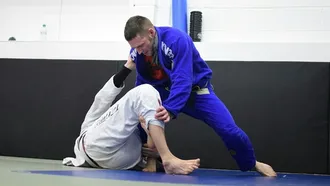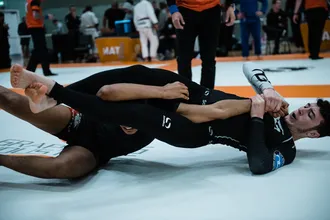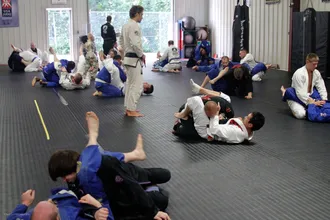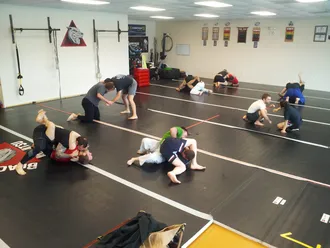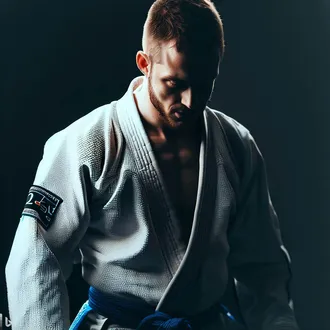
In the realm of martial arts, Brazilian Jiu-Jitsu (BJJ) stands out as a discipline that refines both physical skill and mental strategy.
As you hear more about BJJ, you’ve probably heard the term 'Gi' and wondered, 'What exactly is it, and why is it important?' In this guide, we’ll break down everything you need to know about the Gi in Brazilian Jiu-Jitsu—its history, purpose, design, and how Gi BJJ differs from No-Gi BJJ.
Introduction to Brazilian Jiu-Jitsu (BJJ)
Brazilian Jiu-Jitsu (BJJ) is a grappling-based martial art that focuses on ground fighting, submissions, and leverage-based techniques.
Originating from Kodokan Judo, BJJ evolved into a distinct art known for its efficiency in self-defense and competitive sports.
One of the defining principles of BJJ is that a smaller or weaker practitioner can successfully defend against and even submit a larger opponent through technique, leverage, and strategy. This concept is reinforced through training with the BJJ Gi, which plays a vital role in both practice and competition.
What is the Gi?
The BJJ Gi is the traditional uniform worn in Brazilian Jiu-Jitsu. It consists of three main components:
- Jacket (Kimono) – Made of durable cotton or ripstop material.
- Pants – Reinforced for durability and mobility.
- Belt – Represents rank in the BJJ belt system.
Training in a Gi is essential for developing precise grips and control, which are fundamental in techniques such as guard passing and lapel-based submissions. If you're curious about the role of the guard in BJJ, it's closely linked to Gi-based strategies and grips.
History of Gi BJJ
The history of the BJJ Gi is deeply rooted in Japanese martial arts. Often referred to as a "kimono," it has undergone significant adaptations since its early days.
Origin in Judo
The concept of the Gi originated from Judo, founded by Jigoro Kano in the late 19th century.
Kano designed the Gi as a durable training uniform, allowing Judo practitioners to practice throws, grips, and submissions without damaging their regular clothes.
Spread to Brazilian Jiu-Jitsu
In the early 1900s, Mitsuyo Maeda, a Judo master, introduced his techniques in Brazil. This led to the creation of Brazilian Jiu-Jitsu, where the Gi remained a key training component.
Development and Adaptation
Over the years, the Brazilian Jiu-Jitsu Gi evolved to meet the unique demands of BJJ. Compared to a Judo Gi, a BJJ Gi typically features:
- A more tailored fit – Reduces excess fabric to prevent grip dominance.
- Thicker collar – Helps withstand constant gripping.
- Reinforced stitching – Enhances durability for intense ground-fighting.
Material and Design
A BJJ Gi is crafted to endure the rigors of intense grappling. It is typically made from thick cotton or a ripstop weave, ensuring durability while remaining breathable for comfort during training.
The design of a Brazilian Jiu-Jitsu Gi differs from a traditional Judo Gi in several ways:
- Fabric Strength: BJJ Gis use reinforced stitching and heavy-duty fabric to withstand constant grips and tugs.
- Fit: A BJJ Gi is typically more form-fitting to reduce excess material that opponents can grip.
- Collar Thickness: A thicker lapel makes it harder for opponents to establish firm grips for chokes.
Gis come in various weights, commonly categorized as:
- Lightweight (250-450 GSM) – Ideal for warmer climates and easier weight cuts in competitions.
- Midweight (450-600 GSM) – Balances durability and comfort.
- Heavyweight (600+ GSM) – Best for longevity and strong defensive grips.
Gi brands often incorporate unique weaves such as pearl, gold, or single weave, each offering different levels of strength, weight, and flexibility.
BJJ Gi vs. Judo Gi: Key Differences
Although Brazilian Jiu-Jitsu originated from Judo, the uniforms used in both sports have evolved separately to fit their respective styles of grappling.
| Feature | BJJ Gi | Judo Gi |
|---|---|---|
| Fit | More form-fitting, reduces excess fabric to prevent grip control. | Looser and more flexible to allow gripping for throws. |
| Collar Thickness | Thicker and stiffer to withstand chokes and grip fighting. | Slightly thinner to allow better mobility for throws. |
| Jacket Length | Shorter jacket to minimize gripping opportunities. | Longer jacket for enhanced control in throws. |
| Pants | More reinforced, as leg grips play a bigger role in BJJ. | Often lighter-weight, as gripping pants is less common. |
| Competition Rules | Fitted Gis required for competitions (IBJJF enforces strict size regulations). | Looser fit allowed to facilitate throws. |
In short, the BJJ Gi is designed for grip fighting and submissions, while the Judo Gi is tailored for throwing techniques. If you’re transitioning between Judo and BJJ, understanding these differences can help in choosing the right gear.
Training and Competitions
Training in a BJJ Gi is essential for mastering traditional grips, controls, and submission techniques.
In Training: Wearing a Gi helps practitioners develop:
- Grip Strength – Gi training emphasizes controlling opponents through collar, sleeve, and lapel grips.
- Technical Precision – Many techniques rely on the Gi for leverage, such as the cross-collar choke.
- Defensive Awareness – The Gi allows for slower, more methodical exchanges, which can improve defense.
In Competitions: Various organizations, such as the IBJJF (International Brazilian Jiu-Jitsu Federation), enforce specific Gi regulations:
- Approved Colors: Only white, blue, and black Gis are allowed in IBJJF tournaments.
- Fit Requirements: The jacket sleeves must reach at least 4cm from the wrist when arms are extended, and the pants must reach within 2cm of the ankle.
- Weigh-Ins: Competitors must meet weight limits while wearing their Gi.
- Disqualification Risks: A Gi that is too short, too tight, or improperly fitted can result in disqualification.
Understanding BJJ Gi rules ensures compliance with competition standards and helps avoid last-minute surprises.
No-Gi BJJ – An Alternative Style
While traditional BJJ relies on the Gi, some practitioners prefer No-Gi Brazilian Jiu-Jitsu, which involves training without the Gi. Instead, athletes wear:
- A rash guard (tight-fitting athletic shirt).
- Grappling shorts without pockets.
Key differences between Gi and No-Gi BJJ:
- Grips: No-Gi focuses more on wrist and body control rather than fabric grips.
- Speed: No-Gi matches are typically faster-paced.
- Techniques: Some Gi-specific submissions (e.g., lapel chokes) are not available in No-Gi.
No-Gi is commonly practiced in submission grappling and mixed martial arts (MMA). If you’re considering transitioning between the two styles, our guide on Gi vs. No-Gi BJJ explores the key differences in greater depth.
Frequently Asked Questions About BJJ Gis
Are BJJ and Judo Gis the same?
No, BJJ and Judo Gis are not the same. A Judo Gi is looser, has a longer jacket, and wider sleeves to facilitate throws, while a BJJ Gi is more fitted, with a thicker collar and reinforced stitching for grip fighting and ground grappling.
Can I wear a Judo Gi for Brazilian Jiu-Jitsu?
While you can technically wear a Judo Gi for BJJ training, it’s not recommended because Judo Gis are looser, making it easier for opponents to control you. Additionally, in competitions, Judo Gis may not meet IBJJF regulations.
Why do BJJ Gis have patches?
BJJ Gis often feature patches that represent a practitioner's gym, team, or sponsors. In competitions, organizations like IBJJF enforce specific patch placement rules to ensure patches do not interfere with grips.
What should I wear under my BJJ Gi?
Most practitioners wear a rash guard under their Gi for sweat control, hygiene, and comfort. Some also wear spats or compression shorts underneath their Gi pants for additional protection.
Are BJJ Gis unisex?
Most BJJ Gis are unisex, but many brands offer women’s-specific cuts with shorter sleeves, narrower shoulders, and tapered pants for a better fit. Always check the brand’s size chart before purchasing.
Can you put a BJJ Gi in the dryer?
It’s not recommended to put a BJJ Gi in the dryer, as high heat can cause shrinkage and weaken the fabric. Instead, air-dry your Gi in a well-ventilated area.
Can you dry clean a BJJ Gi?
No, dry cleaning a BJJ Gi is not recommended. The chemicals used in dry cleaning can weaken the fabric and reduce its lifespan. Always wash your Gi in cold water and air-dry it for longevity.
Do I need a Gi to start Brazilian Jiu-Jitsu?
It depends on the gym. Many BJJ academies allow beginners to start training in No-Gi gear (rash guards and shorts) before purchasing a Gi. However, if you plan to train in Gi BJJ, you will eventually need to get one.
What color Gi should I get for BJJ?
Most academies allow any Gi color for training, but IBJJF competitions only permit white, blue, or black Gis. Some gyms have specific Gi color requirements, so check with your instructor before purchasing.
How do I choose the right BJJ Gi size?
Gi sizes are labeled A1, A2, A3, etc., with different brands having slightly different fits. Always check the brand’s size chart before buying, and consider shrinkage if it's 100% cotton.
How often should I wash my BJJ Gi?
You should wash your Gi after every training session to prevent bacteria buildup and unpleasant odors. Not washing your Gi regularly can lead to issues like ringworm and staph infections, which are common in BJJ if hygiene is neglected. Avoid using hot water to minimize shrinkage.
Can you use a BJJ Gi in Judo?
Yes, you can wear a BJJ Gi for Judo training, but it’s not ideal. BJJ Gis are more fitted with shorter sleeves, making gripping for throws more difficult.
How long does a BJJ Gi last?
A well-maintained BJJ Gi can last 1-3 years, depending on how often you train. Heavier Gis (600+ GSM) and reinforced stitching tend to last longer.
In a Nutshell
The BJJ Gi is more than just a uniform; it embodies the essence of Brazilian Jiu-Jitsu—tradition, discipline, and technical mastery.
Whether you’re a beginner or an advanced practitioner, training in a Gi is a crucial part of developing grip control, defensive awareness, and a deeper understanding of BJJ techniques.
So, the next time someone asks, "What’s the deal with the Gi?", you can confidently explain that it’s not just fabric—it’s an essential part of BJJ’s legacy and effectiveness.
Embrace the journey, keep training, and remember—your Gi is more than just a uniform; it’s a symbol of your dedication to the art of Brazilian Jiu-Jitsu!
